Exhibitionary Feedback. On Cybernetic Serendipity
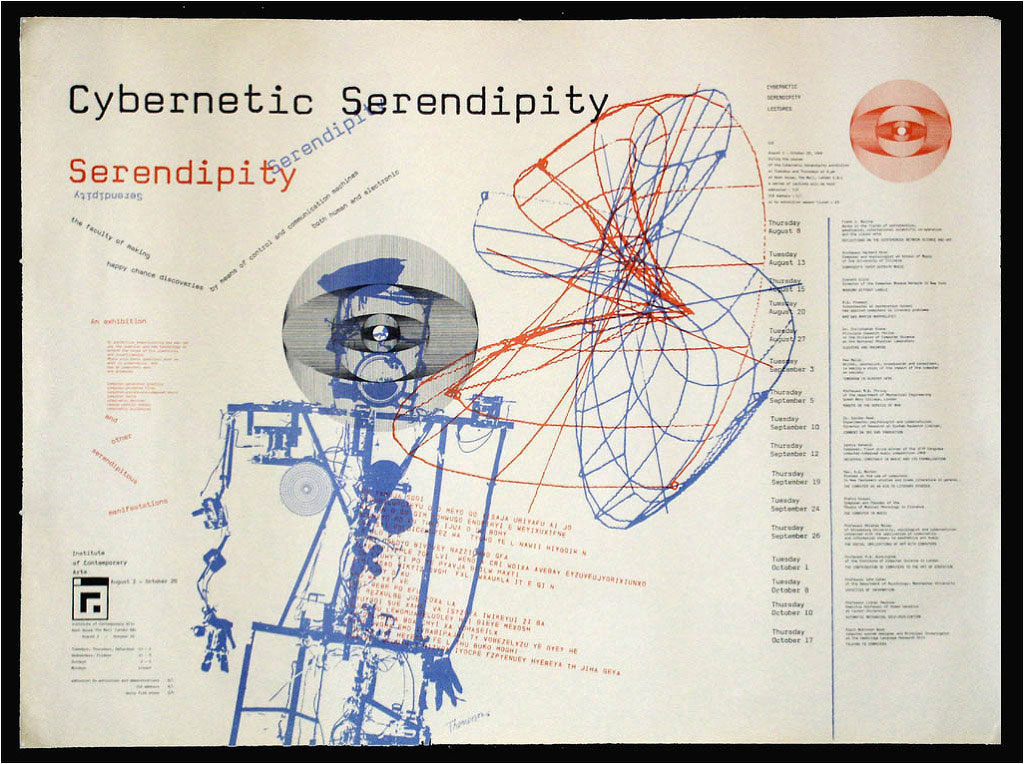
Cybernetics in the Gallery
Taking place in 1968 at London’s Institute of Contemporary Arts (ICA)1 – a major node in the network of innovative art institutions emerging in Europe at the time – the exhibition Cybernetic Serendipity brought together forty-three composers, artists, and poets alongside eighty-seven engineers, doctors, computer systems designers, and philosophers. By exhibiting the work of artists and scientists together, without distinguishing them from one another, curator Jasia Reichardt sought to interrogate the nature of works of art and of cybernetic artefacts. Cybernetic Serendipity was conceptualized less as a traditional exhibition than as an “exploration and demonstration of connexions between creativity and technology (and cybernetics in particular),” as Reichardt wrote a few years after the show.2 She added that it was intended to investigate “the links between scientific or mathematical approaches, intuitions, and the more irrational and oblique urges associated with the making of music, art and poetry.”3
With its cunning title, joining “cybernetic” with “serendipity,” Reichardt placed the exhibition under the aegis of cybernetic control, on the one hand, and chance operations, on the other. In the show’s press release, Reichardt made explicit reference to the ideas developed in Norbert Wiener’s Cybernetics: Or Control and Communication in the Animal and the Machine (1948):
The term today refers to systems of communication and control in complex electronic devices like computers, which have very definite similarities with the processes of communication and control in the human nervous system. A cybernetic device responds to stimulus from outside and in turn affects external environment [sic], like a thermostat which responds to the coldness of a room by switching on the heating and thereby altering the temperature. This process is called feedback.4
Wiener’s volume, first published twenty years before Cybernetic Serendipity, constitutes the canonical point of reference in the field he helped establish by bringing together – starting with his mathematical work on the development of anti-aircraft artillery during World War II – a range of scientists concerned with issues as diverse as computing machines, communication engineering, biological sciences, physics, the brain sciences and psychology, as well as anthropology. Recounting his many encounters across these scientific communities, Wiener became aware in the mid-1940s, he wrote, of an “essential unity of the set of problems centring about communication, control and statistical mechanics, whether in the machine or in living tissue.”5 As both living and nonliving organisms came to be analogously understood as information-processing entities – adapting themselves to their environment via the mechanism of feedback, thanks to which living and nonliving entities achieve a state of homeostasis – cybernetics triggered novel visions of machines (as self-learning and self-generating), of nature (as capable of being technically engineered and constructed), and of thought itself (models and simulations opening the possibility of a machine intelligence). Wiener’s intervention also implied that all organisms, living or technical, could be apprehended using the same conceptual framework and vocabulary. Consequently, Wiener gave the following minimal definition: “We have decided to call the entire field of control and communication theory, whether in the machine or in the animal, by the name Cybernetics, which we form from the Greek κυβερνήτης or steersman.”6
Although the works presented in Cybernetic Serendipity could by no means be entirely subsumed by Wiener’s definition, it was according to just such an openly conceived definition of cybernetics that Reichardt was able to mount her heterogeneous curatorial assemblage.7 As the press release further stated, “exhibits in the show are either produced with a cybernetic device (computer) or are cybernetic devices in themselves. They react to something in the environment, either human or machine, and in response produce either sound, light or movement.”8 One of the main concerns of the exhibition was to present an array of works that together brought into question the act of creation by machines and humans, so that no visitor would “know whether he [was] looking at something made by an artist, engineer, mathematician, or architect” – nor did it matter, Reichardt wrote, whether or not one knew “the background of the makers of the various robots, machines and graphics.”9 With regard to Reichardt’s statement on the modalities of creation and the relative indifference as to the nature of the originator of each of the pieces in the exhibition, feedback (between a human or machinic organism and its surroundings) seemed to take centre stage as the main agent of (artistic/nonartistic) production.10 Indeed, if this undifferentiated way of presenting artworks alongside cybernetic devices pointed to a transdisciplinary commitment to asking visitors to reconsider what counts as creativity, feedback stood as a nonanthropocentric mode of creative agency that enabled a collapsing of the Cartesian distinction between human and automaton.
Consequently, the exhibition consisted of three distinct sections, each of which engaged with a specific modality of this epistemological reconfiguration, ranging from a more conventional understanding of creation to a complete reconsideration of aesthetic objects and their appreciation, prompted by the cybernetic works. The three sections were as follows:
- Computer-generated graphics, computer-animated films, computer-composed and -played music, and computer poems and texts.
- Cybernetic devices as works of art, cybernetic environments, remote-control robots, and painting machines.
- Machines demonstrating the uses of computers and an environment dealing with the history of cybernetics.11
The structure of the exhibition was in itself a testament to a certain will to move beyond the art historical and museological conventions of the time, with curating still largely informed by linear readings centred around authors, schools, or national contexts. Instead, for Reichardt, “the main substance of the Cybernetics Serendipity exhibition was information – the exhibits themselves consisting of objects, diagrams, films and sounds acting as illustrations of the various principles and ideas of which the information consisted.”12 This definition of the exhibition as privileging information – the latter understood as being embodied in a variety of media – essentially established the gallery as a discursive space, and in this regard Cybernetic Serendipity foresaw contemporary curatorial experiments that deal foremost with concepts, a curatorial genre Bruno Latour has dubbed Gedankenaustellung (thought exhibition).13
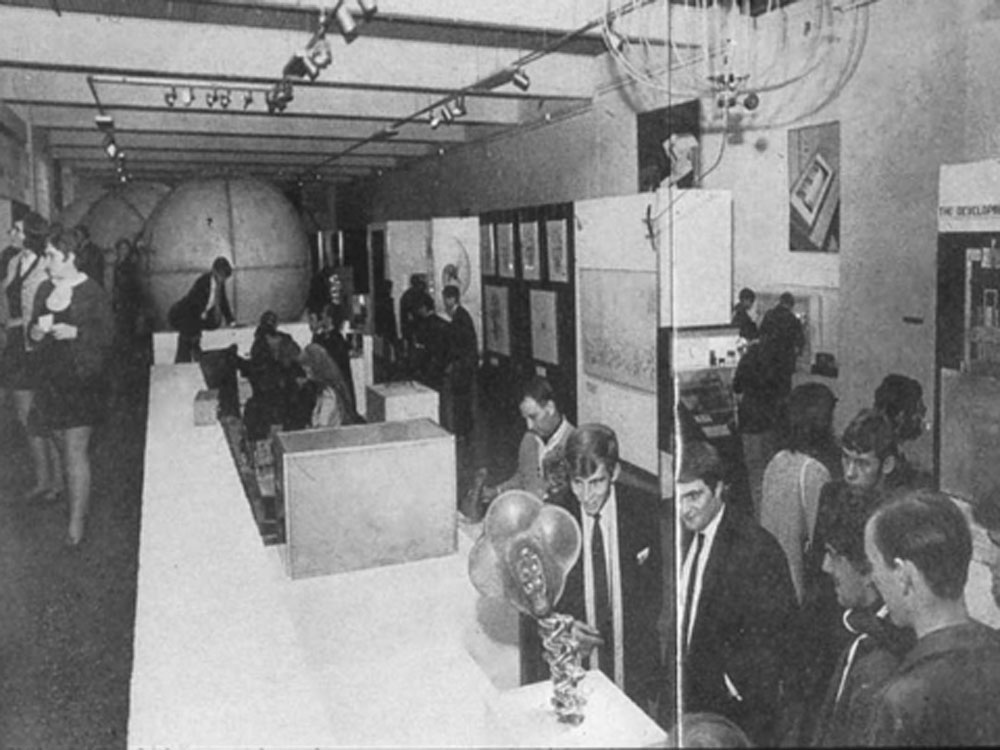
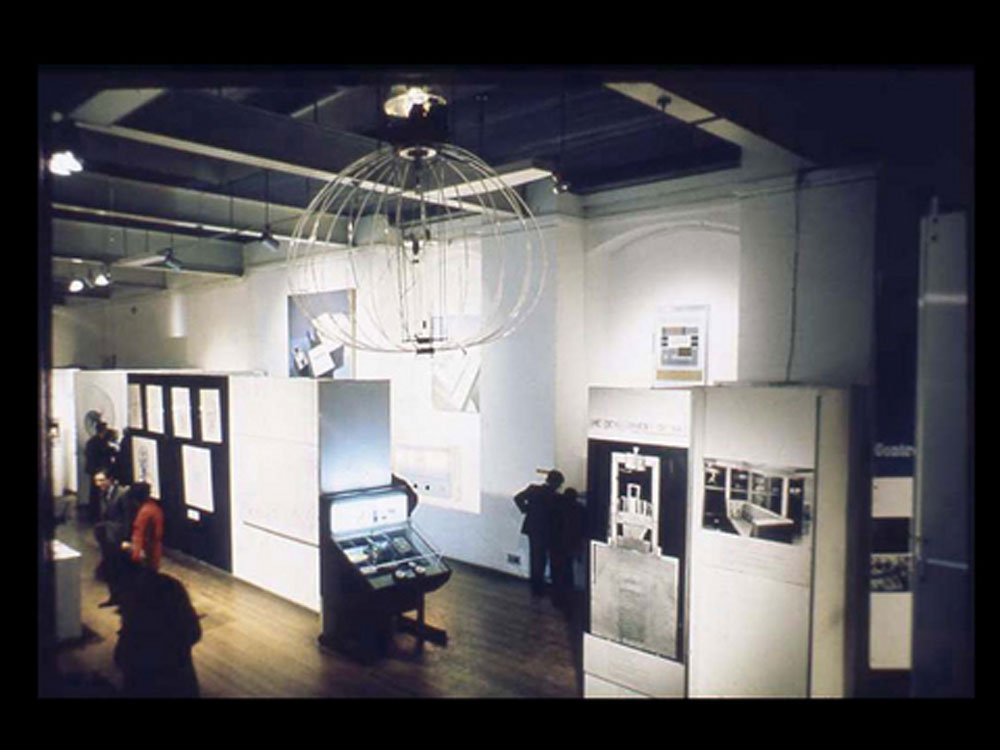
The thought experiment at work in Cybernetic Serendipity was one testing the boundaries between the technical and cultural worlds. As Reichardt put it, “whereas new media inevitably contribute to the changing forms of the arts, it is unprecedented that a new tool should bring in its wake new people to become involved in creative activity, whether composing music, painting or writing.”14 And as one French reviewer asserted, “generally speaking, these researches should result in a merger, highly beneficial for civilization, between technicians and artists.”15 In the United Kingdom at the time, much of the debate surrounding the relationship between art, technology, science, and the machine engaged with the physicist C.P. Snow’s lecture-turned-book The Two Cultures, in which he famously described the divide between science and the arts and humanities.16 To some extent, Cybernetic Serendipity can be seen as an attempt to refashion or reconcile this gap by actively suspending the identifcation of the works on display in such terms.
Probing the possible cross-pollinations between cybernetics and art in an essay in the art journal Leonardo published a year after Reichardt’s exhibition, the psychologist and cyberneticist Michael J. Apter identified three ways in which cybernetics were of relevance to art: first, the “understanding of artistic behaviour”; second, “creating works of art” through cybernetics; finally “cybernetics as art.”17 The first point, which is the least important for our discussion, relates to cybernetics as a means of shedding light on artistic behaviour whose complexity, Apter pointed out, involved “control and communication.”18 More to the point is the author’s typology of the various ways in which cybernetics could be used in the production of art, starting with “[t]he idea of machines as works of art” promoted by cybernetics, since this demonstrated “how arbitrary the living/non-living distinction” was.19 The second point refers to the use of “[m]achines to create works of art,” which, for Apter, included most of the works on display in Cybernetic Serendipity and which he saw as representing “a high point in the early development of a self-consciously cybernetic art.”20 Apter stressed the shift from a conception of art predicated on its objecthood to the notion of “[a]rt as a process,” cybernetics itself emphasizing processual dynamics echoed in the arts by “the deliberate and creative utilization in some works of kinetic art of the participation of the spectator, i.e. of feedback between the spectator and the work of art.”21 Deciphering the impact of cybernetics on art from what he observed under these three subheadings, Apter further noted a “blurring of some of the traditional distinctions between the work of art and the system which creates the work of art, and between the work of art and the system which observes the work of art.”22 Finally, for the last type of relationship identified by Apter, namely “[c]ybernetics as art,” which Apter considered the most “intimate” between the two spheres, he hypothesized that cybernetics was “in part, an art form as well as being a science.”23 If certain other kinds of science may already have entailed elements that could be considered artistic, the novelty of cybernetics was that it appeared to “generate art even in its pure science aspects.”24
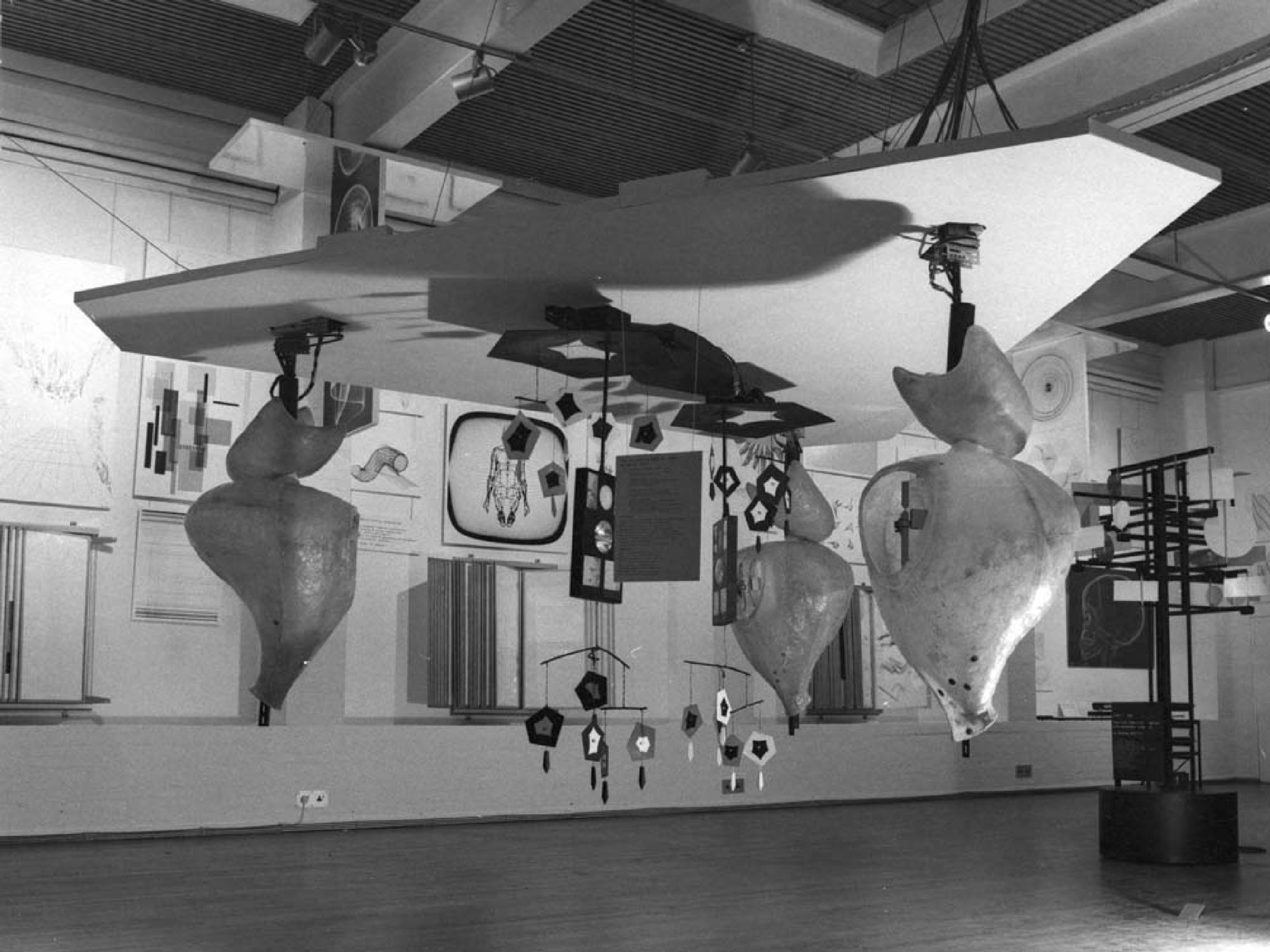
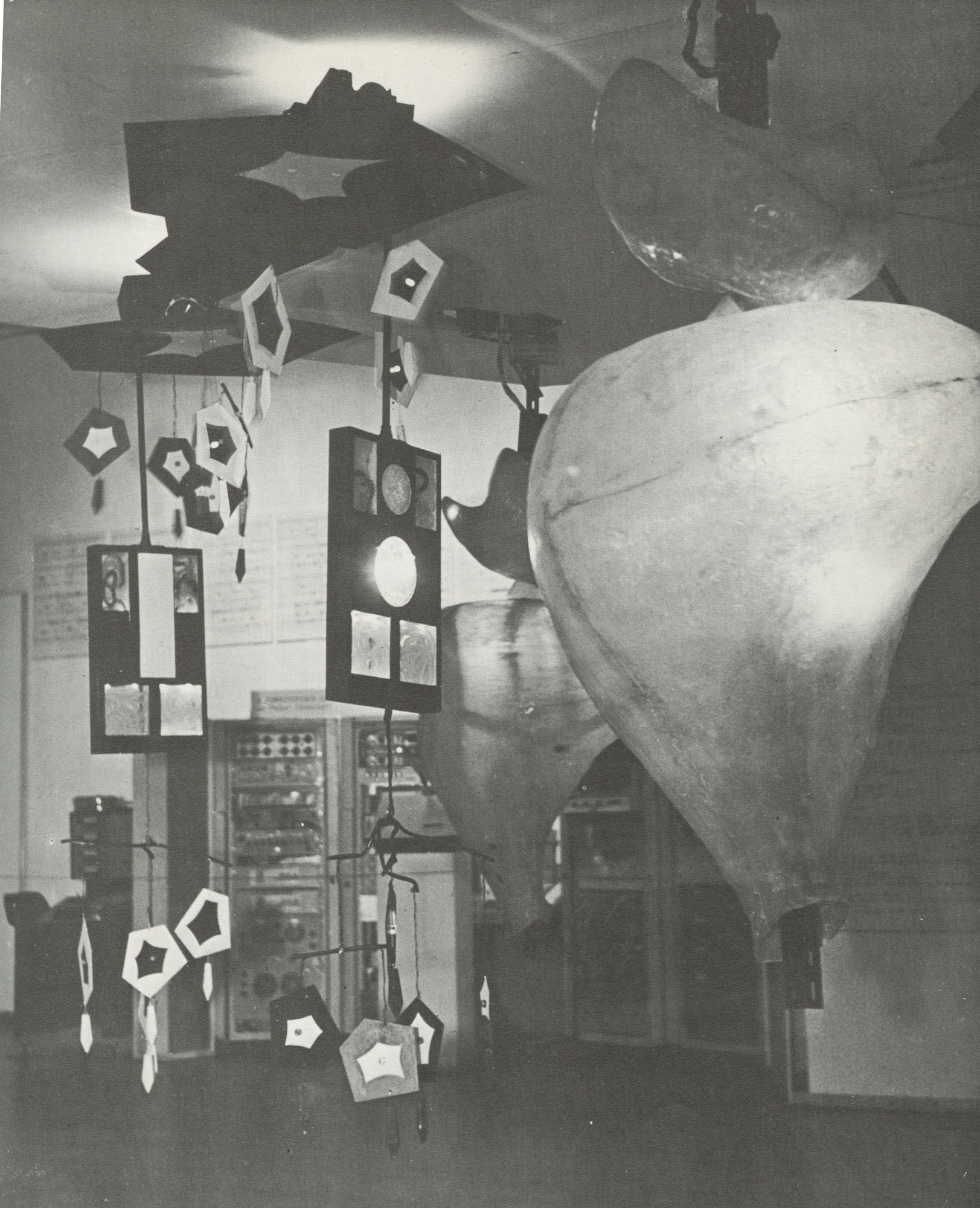
“Aesthetically Potent Environments”: Gordon Pask’s Colloquy of Mobiles
Despite his systematic definition of the ways in which the processes and artefacts of cybernetics could be considered “artistic,” Apter never mentioned the inverse: that art and artists could likewise inform or even be considered as “scientific.” Nevertheless, the blurring of distinctions that he identified between art and related systems, as well as his observations about the artistic character possibly inherent to cybernetics, cogently summed up the conceptual coordinates of Cybernetic Serendipity. Among the various conceptual takes on the analogy between cybernetic and artistic entities was the cybernetician Gordon Pask’s idea of “aesthetically potent environments.”25 Based on his observation of social environments characterized by the search for what he called “social communication, conversation and other modes of partially co-operative interaction” that “represent an essentially human and an inherently pleasurable mode of activity,” Pask saw aesthetic potency in “environments designed to encourage or foster the type of interaction which is (by hypothesis) pleasurable.”26 Proceeding from these principles while substantially expanding and complexifying them, Pask presented in Cybernetic Serendipity a piece he had described in a “plan” a few months earlier as an “aesthetically potent social environment.” A realization of one such environment was his Colloquy of Mobiles, an installation of five mobiles hanging and moving from a ceiling in one of the ICA galleries. Intended to advance possibilities of “artistic communication” and predicated on furthering (re)activity and participation, Pask conceived of the Colloquy of Mobiles as “a group of objects” in which “the individual mobiles that engage in discourse, […] compete, co-operate and learn about one another.”27
The Colloquy of Mobiles staged male and female robots in a complex and open-ended mating game, the very activation of lights and sounds emitted from either the male or female electromechanical beings corresponding to movements of “cooperation” and states of “satisfaction” on their part. As Pask explained it, “[t]he male mobile has two ‘drives,’ O and P (associated with orange- and puce-coloured light) and its drive state is indicated visually by an upper display, A. Its main goal is to satisfy (or reduce) the O and P ‘drives’ which normally build over time.”28 In this social environment for machines, cybernetic individuals engaged autonomously in communication – males and females amongst themselves, as well as each individual of a group with members of the other gender – the goal being, ultimately, that a female would be “willing to co-operate” by producing “an identifying sound in synchrony with the intermittent light signal.” Alternatively, such a “co-operative encounter” would end “after a short time if reinforcement [did] not occur, or if it [was] externally disrupted.”29
If its design based on metaphors of drives and sexual satisfaction can be regarded as somewhat unsophisticated, the Colloquy of Mobiles was actually a rather remarkable apparatus and early experiment with forms of nonorganic organization, life, and communication, with Pask conceiving it as a “socially orientated reactive and adaptive environment,” in which “[e]ven in the absence of a human being, entities in the environment communicate with and learn about one another.” The installation was designed to interact with human visitors, who could “enter the environment and participate; possibly modifying the mode of communication as a result.”30 Each mobile element could actively learn through a form of programmed mimesis, as each time they achieved satisfaction, primary goals and subgoals would become further hierarchized, producing new sets of light and sound signals in the pursuit of further goals. On that level only, for Pask, could the environment be considered an “aesthetically potent” one. But as he further emphasized, “the really interesting issue is what happens if some human beings are provided with the wherewithal to produce signs in the mobile language and are introduced into the environment,” raising the issue of a more literally human-robot sociality and form of communication. Pask concluded that:
the mobiles produce a complex auditory and visual effect by dint of their interaction. They cannot, of course, interpret these light and sound patterns. But human beings can and it seems reasonable to suppose that they will also aim to achieve patterns that they deem pleasing by interacting with the system at a higher level of discourse.
I do not know. But I believe it may work out that way.31
As a synthetic, dynamic, and active machine-man social environment in which both organic and mechanical beings perform, the Colloquy of Mobiles does not belong to either art or science but to the plane of our common sensorium as a whole.
The sociologist and historian of science Andrew Pickering goes so far as to claim that Pask’s endeavours in the art world epitomized the formation of an entirely new ontological plane he refers to as “nonmodern.”32 Writing about Pask’s cybernetic art projects within the field of British cybernetics (which included most notably Ross Ashby and Stafford Beer, the latter also a participant in the ICA show), Pickering claims that the British strand of experiments provides us with an alternative picture and understanding of the cybernetics traditionally associated with Wiener, John von Neumann, or Warren McCulloch, whom he sees as representatives of a modernist version of cybernetics from which emerged its identification as a force and form of control and government. Hence, in contrast to this modernist tradition, Pickering gives a generic definition of cybernetics as: “an instantiation of a different paradigm from the one in which most of us grew up – the reductive, linear, Newtonian, paradigm that still characterizes most academic work in the natural and social sciences (and engineering and the humanities, too) – “the classical sciences”, as Ilya Prigogine and Isabelle Stengers (1984) call them.”33 For Pickering, cybernetics as performed by Pask and his colleagues ushered a move away from science as understood in epistemological and representational terms (prompting, by the same token, science and technology scholars to revise the epistemological foundations of their work and to operate under what he calls the “representational idiom”).34 Similar to Bruno Latour’s conception of “the Modern Constitution” and his call for the making of an amodern world,35 Pickering distinguishes two kinds of ontologies. The first, the “modern ontology,” conceives of the “material world as passive, something that sits around waiting for us, human agents, to represent it (to map it, describe it, theorise it, know it).” This image thus implies that “epistemology – a meditation on representation – is the only worthy topic for philosophical contemplation.” In contrast, a “nonmodern ontology” views “the world – human and nonhuman – [as] a lively place of performatively interacting and endlessly emergent systems (of which we humans are just one sort).”36 For Pickering, Pask’s work is an “ontological theatre”37 in which “[e]ach of the robots had its own inner dynamics, but [was] open to outside interference,”38 and is paradigmatic of the way in which “cybernetics directly thematizes the unpredictable liveliness of the world, and processes of open-ended becoming.”39
Pickering’s view on Pask, and on cybernetics and the arts in general, contrasts with other, more negative views of the social, technological and political forces associated with cybernetics in the 1960s, which mostly relate it to the emergence of what Gilles Deleuze, following William Burroughs, coined “Societies of Control,” in which control functions as a permanent, fluid, and networked modulation.40 As Deleuze put it, in the former “disciplinary” societies described by Michel Foucault, “[e]nclosures are molds, distinct castings” whereas since the postwar “controls are a modulation, like a self-deforming cast that will continuously change from one moment to the other, or like a sieve whose mesh will transmute from point to point.”41 The apparatuses used by Foucault as examples of sites of disciplinary confinement, the “environments of enclosure” as Deleuze calls them in his subsequent reassessment, include the “prison, factory, hospital, school, family.” In this regard, and to probe Pickering’s notion of an “ontological theatre,” it is tempting to discuss Cybernetic Serendipity in light of such conceptions of cybernetic modulation, as well as by looking at another site that Foucauldian scholarship has traditionally conceived of in terms of “environments of enclosure.” Indeed, as Douglas Crimp famously put it in his application of Foucault’s analytics in On the Museum’s Ruins: “There is another such institution of confinement awaiting archeological analysis – the museum.”42 Here the question arises whether Cybernetic Serendipity signalled the shift evoked by Deleuze, and whether the emancipatory politics of Pickering’s cybernetic ontology defined the exhibition as a whole.
Participation and the Cybernetization of the Exhibition
Among the many notable aspects of Cybernetic Serendipity was that the exhibition constituted a particularly favourable ground for audience participation. For instance, the computer graphics artist Peter Milojevic, who participated in the exhibition, wrote that “[t]he public at large likes to participate, and is becoming more active. We have seen the public choosing the ending of a film, adjusting stereo-recording equipment affecting their environment in many ways which are new.”43 This notion of an active and participatory subject was not only an effect of the open structures of the works, which invited what was an unusual behaviour towards them in the gallery, but was also one of Reichardt’s intentions for the show as outlined in her Project for an Exhibition, which included “Audience participation” as a specific entry. She elaborated in the document: “It is hoped to have a computer or a graph plotter with visual display on the premises so that the visitors can produce [,] with the help of a technical assistant, their own computer graphics. The visitors will also be able to operate the various cybernetic devices.”44
In Cybernetic Serendipity, it was clear that the machine-man interactions rested not on an essentialist definition of these two kinds of beings, but instead offered a pattern for a new type of social, technical, and aesthetic dynamic, namely an emerging modality of mediation between objects, viewers, and institutions and a corollary new mode of spectatorial attention according to the principle of feedback in the sense of a system of organized retroactions. If participation was explicitly put forward as one of the novelties of Cybernetic Serendipity, it was also one of its most misunderstood ideas. As Reichardt remarked, there was much confusion as to “whether the act of audience participation was supposed to be creative in itself” and, if so, “should it not produce art as an end product.”45
Reichardt embraced the French cybernetician Abraham Moles’s dismissal of the “authenticity of a work of art” in favour of the “authenticity of situation,”46 situations realized, she wrote, thanks to
the machine [that] is seen in various contexts as a competent assistant to man, a conversational companion, a tool, a background against which human frustration and hopes are seen in a different light, as a labour-saving device, as an instrument for improvisation, as an instrument for amplifying happiness and promoting pleasure, as a means of democratizing art, as a tool for making art, as well as learning something about how it comes about and how it functions.47
The result of these new forms of behaviour – afforded by the “cybernetic ontology” of Cybernetic Serendipity and the symmetrical human-nonhuman agencies it presented – was the concrete reshaping of its institutional context in its spatial, technical, and material conditions. As I have suggested elsewhere, this process relating to a new ontology of the medium of the exhibition might be called the “cybernetization of the exhibition.”48 Indeed, Cybernetic Serendipity was conceived as part of a new agenda by the ICA and contributed to refashioning its identity as a cultural venue. In a special issue devoted to Reichardt’s show, the ICA’s magazine included a one-page description of its new mission, stressing its role as a platform for “contemporary art, music, poetry, film, as well as other creative realms which are less easy to classify.”49 Demonstrating the ICA’s will to embrace culture at large, in whatever forms were yet to come, the text further stated that, “[t]oday the ICA activities embrace fields such as pneumatics, pop music, cybernetics, electronics and mixed media performances – in the fifties it was tachism in painting, new brutalism in architecture and science fiction in films. As new possibilities arise ICA has been and will be tackling them.”50
Furthermore, as Michael Kustow (who took up his position as a director of the ICA a few months before the opening of Cybernetic Serendipity) pointed out, there was in Europe in the late 1960s a “loose network of cooperation which exist[ed] between European museums includ[ing] the Moderna Museet in Stockholm, the Stedelijk of Amsterdam, the Eindhoven museum, the Musée d’Art Moderne and the Centre National d’Art Contemporain in Paris, the Kunsthalle in Bern, the Akademie der Künste in Berlin, the Tate Gallery and the ICA, London.”51 This network was conceived and organized by famed curators such as Harald Szeemann, Pontus Hultén, and Pierre Gaudibert who sought to develop new types of art institutions that could respond to the artistic and cultural, as well as the social, political, and technological, mutations of the 1960s.52 The emergence of such new museums happened at the juncture of several factors. First, the necessity to accommodate artistic experiments of the 1960s whose forms radically questioned the museum’s traditional structure and functions. Second, an increasing reflexivity of art institutions towards themselves and their social missions, especially in light of the upheavals of the late 1960s; indeed, as stated by leading curators in a UNESCO report transcribed by Szeemann: “We must no longer regard the museum as just an instrument for offering art to the public. The museum has become more critical both of art and of itself, because it has become aware of its function outside daily life. It does indeed function outside the system, sets itself up in opposition to the establishment, yet continually shows itself to be an instrument of the system.”53 Both of these factors can be seen as having been cyberneticized, the new aesthetic, social, political, and infrastructural imperatives of the museum being recast by a broader epistemological transformation towards conceiving of all entities as information-processing systems. In the field of cultural institutions, this transformation has resulted in a conception of museums as centres of information or communication, one of the effects being a closer involvement of museums with research and universities and, at the same time, an increased popularity of museums among a general audience.
Covering this mutation of art institutions through series of interviews with its main representatives published in the French art magazine Opus International, the critic Yann Pavie observed that this emerging culture, “directly confronted with daily life […] [,] required the establishment of broadcast centres (centres de diffusion),” the latter constituting “the new status of the institution/museum as research institute and foundation for creativity.”54 The art historian Jean Clair similarly addressed this topic in a 1972 interview with Jonathan Benthall, controller of the ICA. Pointing out the “intellectual sophistication” of the London institution whose program at the time of the interview included talks about linguistics and structuralism, Clair questioned his British respondent about the ICA’s new function, which he saw as akin to that of a people’s university. Benthall replied, “what we are trying to do especially, is to help scientists, philosophers, artists, people from all disciplines, confront and integrate their experiences in a more expanded cultural context. What I am simply trying to say is that there aren’t two cultures, scientists one on side, and artists on the other, there isn’t such a hiatus. […] Culture can be envisioned as a unity.”55 In the discussion between Clair and Benthall, the idea of a unity of scientific and artistic culture resonated with Snow’s Two Cultures.56 In addition, the editors (most likely Clair himself, as he was the chief editor at the magazine) chose to illustrate the article mainly with shots from Cybernetic Serendipity. While we cannot know for sure the editors’ motivation in using these shots, this nevertheless points to the undeniable fact that Reichardt’s exhibition, in exhibiting cybernetic devices and artworks, was at once symptomatic of and an active agent in the process of cyberneticizing the ICA.
Contemporary to Cybernetic Serendipity’s display of machine-assisted artworks and to the ICA’s redefinition as information centre were the philosopher of science Georges Canguilhem’s writings on the new forms of rationality at work in the field of biology. He discussed these through the concept of “regulation,” distinct yet transversal to conceptualizations of organisms in both the life and communication sciences. First written as an entry on “Regulation” for the Encyclopédie Universalis in 1968, Canguilhem contended that: “Today, the concept of regulation encompasses the quasi-totality of the operations of the living being: morphogenesis, regeneration of mutilated parts, maintenance of dynamic equilibrium, adaptation to living (vie) conditions in the milieu. Regulation is the biological fact par excellence. This is the reason why current interpretations of regulation processes look for their most expressive models in information theory and in cybernetics.”57 Following Canguilhem, it would prove very fruitful for exhibition studies to examine the new socio-technical forms of the 1960s through the museum as redefined, through the lens of cybernetic rationality, in relationship to the biological sciences. This would be another project which exceeds the scope of the present article. However, it does reveal the circulation of pervasive concepts that have come to inform most strata of postwar Western society. And although the cybernetization of the ICA did not lead to a programmatic materialization of information theory to the same extent as it did, for instance, for the Centre Pompidou, such a process nevertheless reshaped its space to the extent that cybernetics became a “hypothesis,” as the media philosopher Alexander Galloway put it, following the Tiqqun collective. On its most general level, Galloway writes, “Tiqqun views the cybernetic hypothesis as a new kind of social management involving both human and nonhuman assets,” and not “merely limited to a few small scientific fields, but as a broad social and cultural ethos with influence across a number of fields and practices.”58
Whether Cybernetic Serendipity embodied Pickering’s version of cybernetics as performing “processes of open-ended becoming” or Tiqqun’s conception of it as an overpowering force governing all strata of existence, works presented in the exhibition, such as the Colloquy of Mobiles, suggested new possibilities for interaction between the living and nonliving, possibilities that diverge from our contemporary moment with its technological teleology fuelled by artificial intelligence and the drive towards systematic automation and prediction. In this sense, Cybernetic Serendipity offers a resource for the present by reopening the question of serendipity.